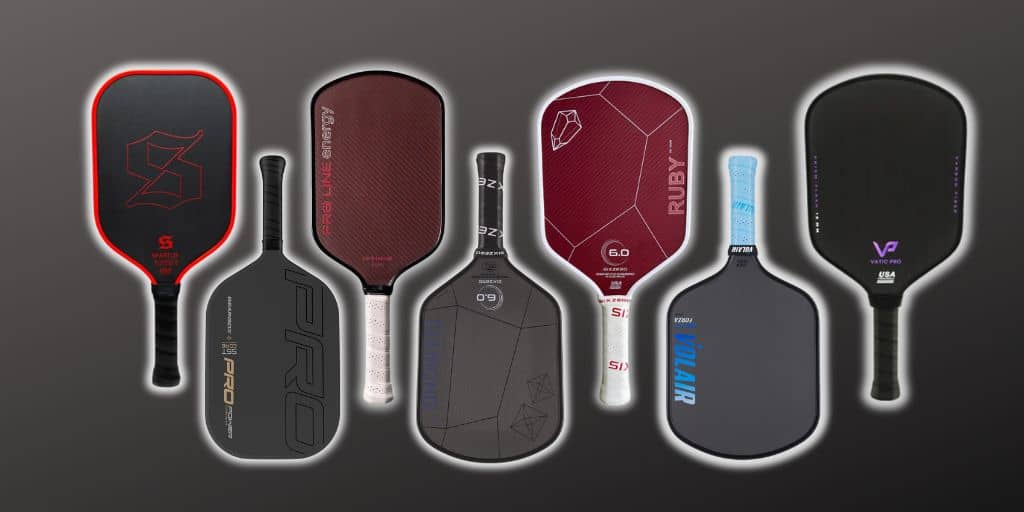If you play pickleball, you’ve most likely come up against someone who uses a spin serve. As a purely rec player myself, I know I sure have.
These tricky serves can be truly maddening. They make the flight of the ball erratic and cause the ball to “kick” left or right unpredictably when it bounces or makes contacts with the paddle.
Spin serves are designed to make it difficult to impossible for an opponent to return. If the receiver does manage to return the serve inbounds, it will likely be a low quality one.
As the game of pickleball has grown, players have found new ways to gain competitive advantages over their opponents, especially in tournament play. The chainsaw serve, a two-handed serving technique used to impart tremendous spin on the ball, was one of the most devastating of these trick serves.
So what’s the deal? Are the chainsaw serve and other spin serves a legitimate part of pickleball or are they just sneaky tactics that are sucking the fun out of the game?
Here’s our take.
What is the chainsaw serve in pickleball?
The chainsaw serve in pickleball is when a player uses their paddle to generate spin on the ball as it is tossed into the air.
The serve was first performed by pro pickleballer Zane Navratil while experimenting with different types of spin using the paddle face, paddle hand, and tossing hand.
He found that by rolling the ball along the face of the paddle – and in some cases even along the handle – as it is tossed in the air, he could generate an immense amount of spin on the ball before it is even struck.
A fast-spinning ball travels unpredictably through the air and when it bounces it will ricochet away from the receiving player in any number of undeterminable directions. Even if the receiver manages to get their paddle on it, the spin on the ball can make it rebound wildly off the paddle face itself, making a controlled, intentional return nearly impossible.
Many players, both recreational and professional, began trying this same serve several years ago, and by 2021 it had become increasingly common on pro and amateur pickleball courts.
It became so common, in fact, that it prompted outcry about how trick serves like these were compromising the integrity of the game.
Is the Chainsaw Serve in Pickleball Legal
No, it’s not.
In response to the complaints from various pickleball communities, USA Pickleball, the sport’s governing body in the United States, promulgated new rules declaring the chainsaw serve illegal in 2022.
The official rules now state that:
“THE SERVE SHALL BE MADE WITH ONLY ONE HAND RELEASING THE BALL. WHILE SOME NATURAL ROTATION OF THE BALL IS EXPECTED DURING ANY RELEASE OF THE BALL FROM THE HAND, THE SERVER SHALL NOT IMPART MANIPULATION OR SPIN ON THE BALL WITH ANY PART OF THE BODY IMMEDIATELY PRIOR TO THE SERVE.” (RULE 4.A.5.)
Since the chainsaw serve must be performed with two hands, this rule expressly bans it from the sport.
The official pickleball rules were changed to address what many considered an unfair and unsportsmanlike method of serving the ball. But that prompts the question, was it the right decision to outlaw this innovative serving technique?
Should The Chainsaw Serve Have Been Outlawed?
While we completely agree with USA Pickleball’s decision to ban the chainsaw serve when it comes to amateur play, the situation in the pro tournament ranks is more nuanced. Here’s why.
Amateur Play
Whether in recreational play or local amateur tournaments, the whole point of playing pickleball is to have fun! And how fun is it when you are receiving a serve that you will probably not be able to return? Most would agree it is no fun at all.
There are competing philosophies in the amateur pickleball community as to whether a serve should be a strategic shot in itself or whether it should just get the ball in play to start a good rally. Reasonable minds can differ as to which approach is the correct one (or in fact if there is any such thing as a “right” way to play the game at all!).
Either way, the chainsaw serve was deemed to impart such a strategic disadvantage to the receiver that it was banned from the game altogether. For those who play pickleball for fun, the complaints are easy to understand.
Let’s face it: the purpose of a chainsaw serve is to get an ace, or at least to make the serve impossible to return, right? How much fun does anyone have when the serving team just keeps hitting ace after ace using a tricky spin serve?
Whether you are on the serving team or the receiving team in this scenario, it does not make for a very good game. Not only will the game be over very quickly, but it will end with few if any quality rallies.
Despite the chainsaw serve being outlawed, competitive players all over the country will continue to experiment with spin and technique as the game of pickleball continues to evolve, so spin serves will remain a part of the amateur game as long as they do not run afoul of the new serving rules.
But what about the pros?
Professional Play
The professional pickleball circuit is a different story. While some may frown upon the use of a monster spin serve like the chainsaw, others argue that it is simply part of the game when playing at the most elite levels.
Having a powerful serve is part of being a professional player, and so is figuring out how to successfully return those serves. So what’s the problem with the chainsaw serve?
And as Zane himself has said, the serve is the one shot over which a player has complete control. Why shouldn’t it be used to gain the greatest advantage at the beginning of a point in tournament play?
At the highest levels of the game, an argument can be made that pro players should be expected to handle any type of shot. It is precisely the task of a professional level player to figure out how to neutralize any given opponent’s advantage and pick apart their strategy.
If everybody on the pro circuit suddenly started using the chainsaw serve, you can bet that players would eventually adapt to it.
Seen through this lens, we think that the decision to ban the chainsaw serve in pro tournament play is questionable.
Chainsaw vs. “Evans Toss”
The Finger Spin Serve Is Still Legal
While the rules for 2022 made the chainsaw serve illegal, that doesn’t mean that spinning the ball on the serve is completely prohibited.
Before Zane Navratil debuted his chainsaw serve, pro pickleballer Morgan Evans was already using a finger spin serve to gain an advantage.
This technique involves spinning the ball with the non-paddle hand as it is tossed in the air.
Rule 4.A.5 states only that the ball must be tossed with one hand, but does not prohibit spinning the ball with the tossing hand prior to hitting it. Therefore, this technique is still completely legal.
You can watch videos of Morgan Evans abusing opponents with his serve and see for yourself how remarkably effective it is. It keeps players off their game and prompts weak returns – whenever the receiver doesn’t just send it wildly out of bounds, that is.
Morgan’s serve is a good example of a high-level tactic that should properly be considered part of professional play. His opponents will either figure out how to hit it, or they will lose.
So it looks like spin serves – or at least finger spin serves – are here to stay.
Final Thoughts
The popularity of pickleball is exploding and shows no signs of slowing down. As the sport evolves and people spend more time on the pickleball court, players will continue experimenting with new techniques to defeat their opponents. Such is the nature of any game about which people are passionate.
But how much is too much? What will be the next innovative development that gives a player a lopsided advantage and will need to be addressed by the official rules? No one can say, but you can be sure it is coming.
That’s our take on it. Where do you come down on the chainsaw serve debate?




